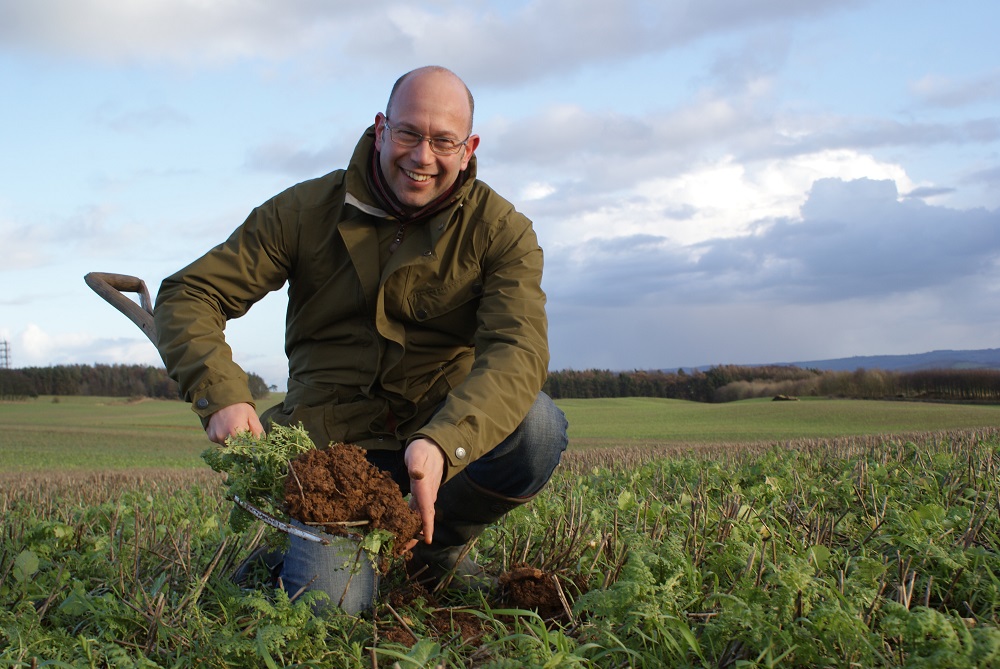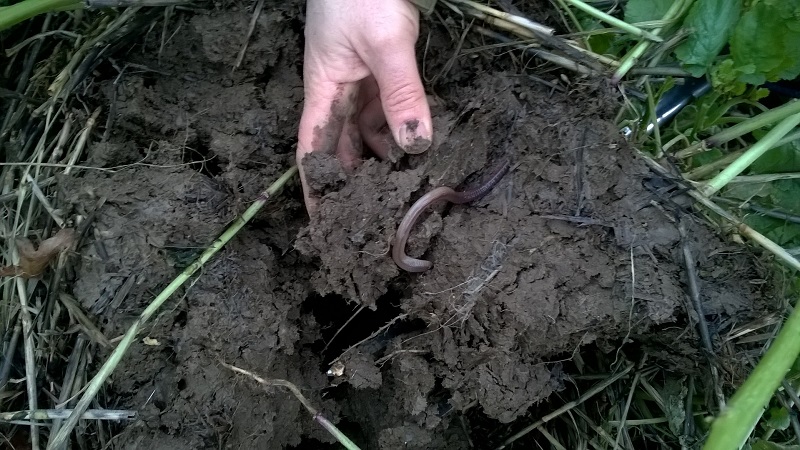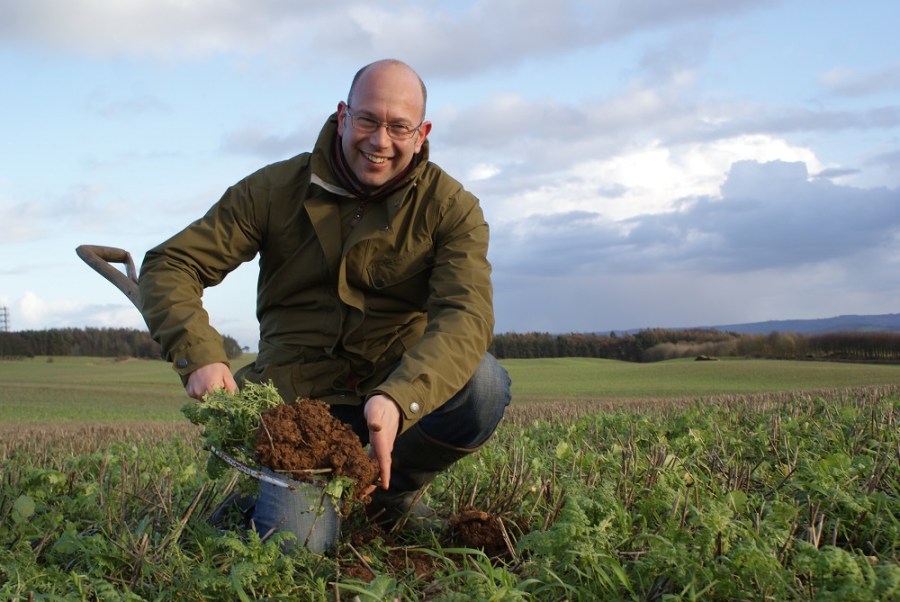
A yearning to understand more about the soils he farms has led the farm manager of one  Glos estate to take the farming system through a radical change. CPM looks beneath the surface.
Glos estate to take the farming system through a radical change. CPM looks beneath the surface.
By Tom Allen-Stevens
Walking into the middle of an arable field in early February and digging up a spit of soil is nothing remarkable in itself. But when the field is heavy Lias clay and your boots barely make an imprint (let alone squelch), even though 40mm of rain fell just 24 hours earlier, you get the feeling something remarkable has happened to it.
When that spit of soil is upturned and it’s teeming with life – a bulbous earthworm struggling to hide in one of numerous burrows, festoons of fungi gathering round a fibrous root system and well structured crumbs falling away as it’s handled – your suspicions are confirmed.
There’s a real thrill to trying something new.
“This field’s in year three,” explains farm manager of Overbury Farms Jake Freestone. “It was TopDown cultivated three years ago, and if you’d come into the field at this time of year then, you’d be clomping along with mud lapping up around your wellies. It’s the zero till and cover crops that have made the difference.”
It’s a change he’s rolled out across the in-hand arable area of the 1900ha privately owned estate in Glos that sits where the Cotswolds meets the Vale of Evesham, overlooking the River Severn. There’s 950ha of combinable crops and 1000 lowland ewes, with a further 125ha let out for field-grown high-value vegetables.

The aim is to keep the soil biology as vibrant as possible throughout the rotation.
“We’ve a soil type that ranges from sand over gravel to heavy Lias clay, with a fair portion of Cotswolds brash. That means trying to find a system we can run across everything is tricky,” explains Jake Freestone.
However, just two years ago, the decision was made to take this traditional country estate fully down the zero-till route. All the mainline arable tractors except one John Deere 8370R were sold, along with most of the cultivation equipment. Then in 2015, the estate invested over £150,000 in a 6m Cross Slot drill.
Radical departure
Jake Freestone admits it’s a radical departure from the plough-based, “old-style” way of farming he inherited when he arrived as farm manager in 2003 – a position he aspired to from a young age. “Both my parents were teachers, but at the age of 11, I fell in love with farming and have spent the rest of my life pursuing this goal.”
That took him through Seale-Hayne College and a number of posts on farms, including a four-year spell with Velcourt, before he came to Overbury Farms. These lie on an estate that has been in the same family for the past 300 years, and has diverse interests, centred on the villages of Overbury and Conderton. 130 privately owned dwellings form a rural community that includes a village school and the Grasshoppers Nursery. There’s a thriving shoot and even a private water supply, fed from the farmland that rises up behind the villages.
“We’re responsible for maintaining the water quality – it makes you very aware of the impact farming has on the local community. But then, sustainable farming practice is very much a core objective for the estate,” explains Jake Freestone.
It’s a LEAF (Linking Environment and Farming) Demonstration farm, and a strong supporter of the organisation. Produce is LEAF-Marque certified, adding a £15/t premium to rapeseed, for example, while Lambing Live and Open Farm Sunday are big annual community events.
But the real change for the farming came when Jake Freestone decided to apply for a Nuffield scholarship. “I’d heard that the genetic potential of the wheats we’re growing is 20t/ha, but for all the chemistry we’re throwing at them, we’re not achieving anywhere near that. It’s clear to me there’s a link with the soil.”
So his Nuffield scholarship became a quest to break the wheat-yield plateau. “It was also an opportunity to travel – ever since I’d left college I’d been so focused on working on farms I’d missed the chance to explore what other farmers were doing around the world. My employer, Penelope Bossom, was very supportive, both in allowing me the time to study, but also in sponsoring some elements of it.”
His tour started with the premier crop research institutes of the UK, before he set off to explore Alberta, Saskatchewan, Oklahoma, Idaho, North and South Dakota, Mexico, New Zealand and Ireland. “The key factor to achieve higher yields in conventional farming is through excellent soil condition,” he wrote in his report.
In Alberta and Oklahoma he saw how minimal soil disturbance, through direct drilling, reduces soil mineralisation and starts to increase soil organic matter. “In South Dakota I saw examples of how cover crops help reduce soil erosion, fix atmospheric nitrogen, assist in the removal of compaction, trap essential moisture and increase microbial activity.”
And it was in New Zealand Jake Freestone came across the Cross Slot drill and the design team behind it. The drill itself is a direct drill claimed to have a remarkably high establishment success rate, placing seed at a consistent depth and coping with high levels of surface trash and residue.
T-shaped slot
Each drilling assembly consists of a disc opener with an L-shaped coulter on each side – one for seed and one for fertiliser. As the assembly slices through the soil profile it creates an inverted T-shaped slot, with seed placed on one side and fertiliser on the other. A set of double press wheels follow and close up the slot. Then, as the seed germinates, it picks up the fertiliser and grows through the channel cut by the disc opener.
“Buying the drill was a huge investment, and we didn’t enter into it lightly, but we’ve managed to cut our costs considerably as a result, and have a system with plenty of spare capacity,” says Jake Freestone. The old plough-based system cost around £150/ha, he recalls, but now the crop is established for just £52/ha. Fuel use is just 12.13 l/ha.
But cost wasn’t the main motivation. He’s convinced the minimum disturbance approach is more beneficial for the soils, and the zero-till system has gone hand-in-hand with a move into cover crops. There’s a whole variety of different mixes under trial in large plots in one field – 11 were grown last year. These are doing a different job, depending on where they’re grown, explains Jake Freestone.
“On lighter land, oil radish and black oats work well to build organic matter. On heavier land, compaction removal and drainage are the focus. We’re also growing stubble turnips for the sheep.”
In total, 453ha went into cover crops in autumn 2015. The lighter land has a rotation of winter barley, followed by oilseed rape, with winter wheat in front of hand-picked peas. There’s a cover crop in front of the peas, and another short cover (or catch crop) between the OSR and wheat crops.
“This is a fast-growing small-seeded mix – you’re aiming to get as many roots as you can, so linseed and phacelia work well. The seed cost is currently £40/ha, although I’m aiming to halve this. But it’ll scavenge up to 100kgN/ha.”
Following the peas, there’s another winter wheat, then another cover crop – usually stubble turnips – precedes spring barley. The heavy land sees the same OSR/catch crop/winter wheat/cover crop sequence. This is followed by spring peas and then one or two winter wheats.
Companion crops
Grown with some of the OSR is a companion crop – along with 50 seeds/m² of DK Exalte, 15kg/ha of vetch and 7kg/ha of buckwheat has been drilled. “It’s saved us the cost of a pre-emergence herbicide, and you get good ground cover which discourages pigeons and competes with the weeds. You then apply aminopyralid plus propyzamide that takes the companion plants out, along with any weeds, and you’re left with OSR at the correct GAI.
“But the main benefit is what these plants do for the mycorrhizal fungi. OSR doesn’t have a relationship with the beneficial, soil-borne fungi, so there’s a 12-month period during which it’s depleted. The companion crop bridges the gap, so the fungi’s primed before the wheat crop goes in.”
The aim is to keep the soil biology as vibrant as possible throughout the rotation, he explains. “If you build the organic matter through encouraging rooting, the resulting soil biology releases more nutrients. This in turn feeds the plant roots, which stimulate the soil biota further, so you get more soil life and the nutrient cycle runs faster.”
With the benefits now showing on Overbury Farms, Jake Freestone is expanding his enterprise. “We have spare capacity with the drill, but I don’t want to be a drilling contractor.” Instead, he’s offering the service as a whole-system approach, where the land is drilled in a rotation that includes cover crops, and he supplies management advice, along with the kit and labour.
And it’s the knowledge element for which Jake Freestone has a feverish enthusiasm. With 7000 followers, @No1FarmerJake is one of Twitter’s most active farmers. Tips are shared, information and observations exchanged and he readily joins conversations on #zerotill, #covercrops and #rootsnotiron.
Circle of knowledge
“I enjoy farmers coming to visit our trials here, and I try and visit other farms and other trials sites as much as I can. It’s not just about communicating what I’ve learnt, but finding out more – I’ve found that if you open up to others, they’ll share what they know with you, so the circle of knowledge moves around.”
So what’s next from this on-farm innovator? It’s clear from his response there’s a long list of ambition. “There’s more to do with companion cropping – spring oats and peas is a mix with some mileage. There’s a new header I want to try on the combine. Also there’s scope in blending varieties – there should be disease and pest benefits from the more diverse cropping environment, if experience in Eastern Europe is anything to go by. And I’d love to produce a LEAF Marque loaf of bread – one that’s low carbon and zero-tilled.”
And this is relayed with Jake Freestone’s genuine, warming smile and more than a glint of excitement. “I get a real kick and buzz out of what I do. There’s a real thrill to trying something new,” he says.
How to be an on-farm innovator – Jake Freestone’s top tips
- Don’t be afraid to think of something new. Just because it hasn’t been done before, that doesn’t mean it won’t work.
- Just try it. Put your theory to the test over a small area at first – it won’t break the bank.
- Have a good team around you. Any business plan will pass or fail on the attitude of those doing the work – make sure you bring them on the journey.
- Demonstrate your ability. Whether that’s to your boss, your family or your bank manager, the more you monitor and record your progress and have those figures readily to hand, the easier it will be to make the changes you want.
- Throw yourself into the technical conversation. Get involved in social media and be prepared to be open and share your experiences (to a point!). Knowledge transfer is two-way, so the more you share, the more you get back.
- Surround yourself with innovation. Go on farm walks, open days and events, get to know like-minded farmers, and invite them to your farm – this is how the circle of knowledge evolves.
The value of vision
What’s particularly impressive about the arable system at Overbury is how closely Jake Freestone’s personal ambitions are aligned with the vision and values of the estate. That’s the view of Ben Miles, part of the BASF team responsible for developing agricultural solutions.
“He’s clearly thought in great detail about the goals and objectives of his employer, taken the environmental concepts they encompass, and turned these into commercial objectives for the farm. What’s more, you see very real examples of how this is being rolled out.”
With the cover crops you can see on the farm both the work that’s underway and in development, as well as areas where they are bringing benefits, he points out. “The difference to the drainage on the Lias clay is phenomenal. Jake also has a really good handle on the business performance – ask him anything, whether that’s five-year average yield or fuel consumption, and the figure comes straight back. It shows he knows how to benchmark his business.”
But it’s not just about the business, notes Ben Miles. “Jake’s whole approach is part and parcel of his own personal development. Throughout his career, he’s sought to develop his knowledge, whether that’s travelling the world on a Nuffield scholarship or visiting a like-minded farmer just down the road. Then, when he adopts this on the farm, he’s careful to bring the rest of the staff along with him.”
The willingness to learn is the first, crucial stage of what makes an on-farm innovator, he believes. “It’s then about knowing how to apply it in your own situation, and trying something new without being afraid it’ll fail. With Jake, you get the feeing there are no failures – just learning experiences.”

For Ben Miles himself, on-farm innovators are the lifeblood for the work he does with BASF. “Innovation lies at the core of what we do. But we can’t do it alone and don’t know what problems need to be solved until an innovation is put into practice. It’s the on-farm innovators who provide the testing ground, who can take a concept and help us
develop it into a practical solution. They also provide a real insight into an arable farming system and the challenges it faces.”
And he feels the benefits are mutual. “What’s clear about Jake is the sense of pride he has in his achievements, and he’s keen to share these. We’re often too quick in farming to beat ourselves up over our failures, but we should also recognise our successes and celebrate these together,” says Ben Miles.




